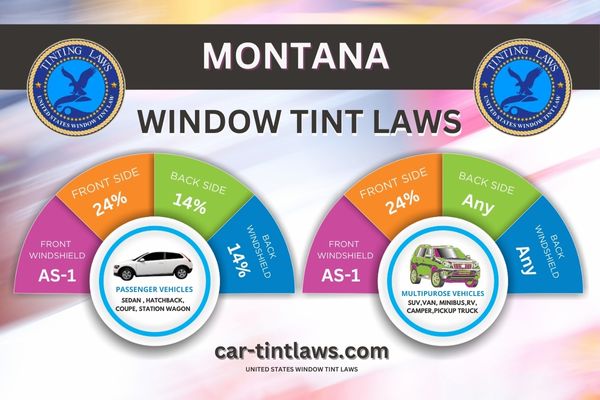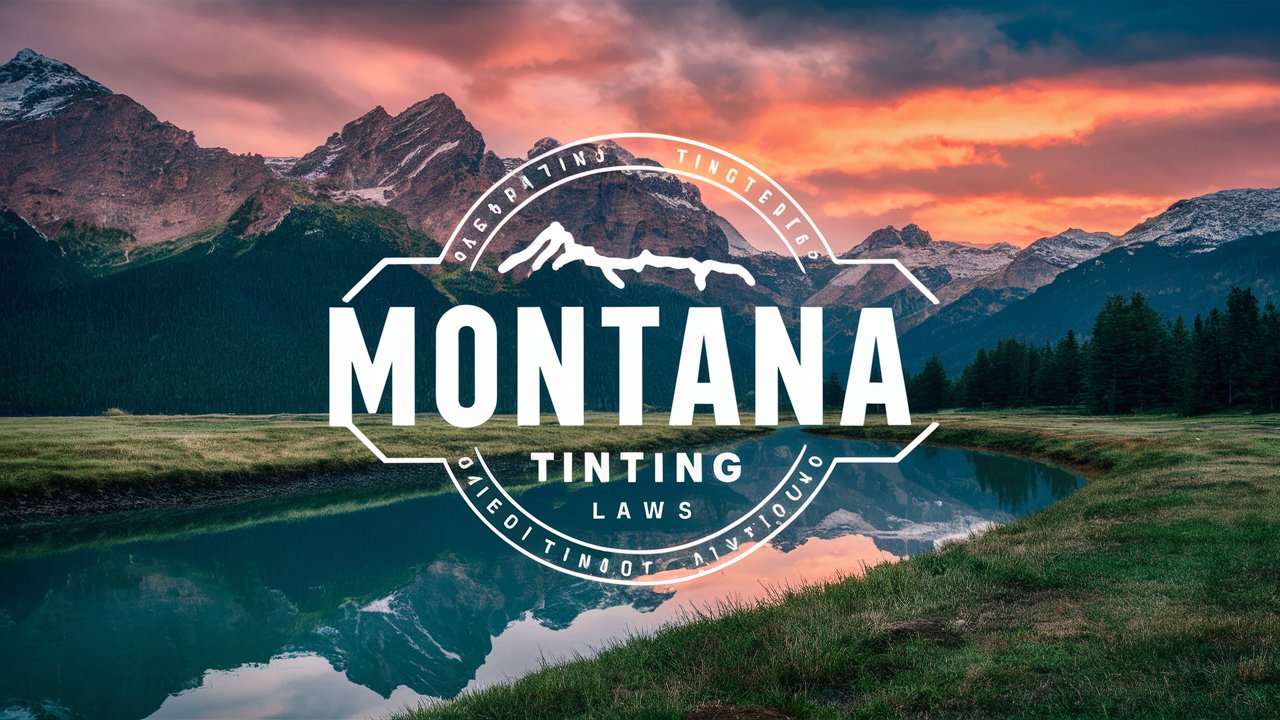Just as the Great Plains stretch on endlessly, the specifics of Montana’s window tinting laws might seem straightforward but hold important nuances you’d want to grasp.
Did you know that while sedans have stricter guidelines for light transmission, SUVs and vans enjoy a bit more leniency on their rear windows?
And it’s not just about darkness; reflectivity plays a role too, capped at 35%.
Plus, there are medical exemptions if you need them. Understanding these rules isn’t just about compliance; it’s also about ensuring your comfort and safety on the road.
Curious about the finer details?
Window Tint Darkness in Montana
When considering window tint darkness in Montana, you’ll need to be aware of the specific VLT requirements for different types of vehicles.
For sedans, the front side windows must allow more than 24% light transmission, while the back side and rear windows must allow more than 14% light transmission.
SUVs and vans follow the same guidelines, ensuring a consistent approach to safety and visibility across various vehicle types.
Tint darkness for sedans:
- Windshield: Tinting above the AS-1 line is permitted.
- Front Side windows: Must allow more than 24% of light in.
- Back Side windows: Must allow more than 14% of light in.
- Rear Window: Must allow more than 14% of light in.
Tint darkness for SUV and Vans:
- Windshield: Non-reflective tint must be applied above the manufacturer’s AS-1 line.
- Front Side windows: Must allow more than 24% of light in.
- Back Side windows: Any shade can be used.
- Rear window: Any shade can be used.
Window Tint Reflection in Montana
When considering window tint reflection in Montana, understanding the specific regulations for different vehicle types is crucial.
For sedans, the state permits up to 35% reflectivity on both front and back side windows, ensuring adherence to safety standards.
Likewise, SUVs and vans must also follow the identical 35% reflectivity limit for their front and back side windows, maintaining a consistent standard across all vehicle categories.
Tint reflection for sedans:
- Front Side windows: Must not be more than 35% reflective.
- Back Side windows: Must not be more than 35% reflective.
Tint reflection for SUV and vans:
- Front Side windows: Must not exceed 35% reflectivity.
- Back Side windows: Must not exceed 35% reflectivity.
Other Montana window tint rules and regulations
- Side Mirrors: No restrictions.
- Restricted Colors: In Montana, all tint colors are permitted.
- Certificates: Manufacturers of film need to certify the film they sell in the state. Ask your dealer if they are using certified film.
- Stickers: The sticker/label of compliance to identify legal tinting is recommended but not a legal requirement in Montana.
- Medical Exceptions: Montana allows medical exemptions for special tint. For more details about the specific terms of the exemption, consult Montana state law.
- Penalties: The cost of a window tint ticket in Montana can vary. First conviction may result in a maximum fine of $100 and/or 10 days in prison. Second conviction within a year may lead to a maximum fine of $200 and/or 30 days in jail. Third and subsequent offenses within a year may result in a maximum fine of $500 and/or up to 3 months in prison.

Medical Exemptions for Window Tint Rules in Montana
If you suffer from conditions like albinism, lupus, porphyria, or photophobia, Montana allows for medical exemptions to its window tinting laws.
These window tint medical exemptions are available to those who need them due to specific light-sensitive medical conditions.
To qualify for a medical exemption for window tint, you need a certification from a licensed physician, physician assistant, or advanced practice registered nurse.
This certification is essential to obtain exemptions for special tint on your vehicle.
Once you have the medical certification, the next step is to submit it to the Montana Highway Patrol or your local law enforcement agency.
They will review your application and, if approved, issue a waiver.
This waiver will include your vehicle identification, the owner’s name, the reason for granting the exemption, the effective date, and the officer’s signature.
Having medical exemptions for special tint not only complies with Montana window tint law but also ensures you can drive more comfortably and safely.
Following the proper certification process allows you to benefit from the protections that these exemptions provide.
Remember, proper documentation is vital for maintaining compliance.
Montana Code section 61-9-428 – Window tinting and sunscreening — waiver — conditions
Montana Window Tint Ticket Cost
Once you’ve grasped the medical exemptions, it’s vital to be aware of the potential costs and penalties for non-compliance with Montana’s window tint laws.
If your vehicle’s window tinting doesn’t meet the legal limits, you could face a Montana window tint ticket cost of up to $500 for a first conviction.
This fine serves as a significant deterrent, guaranteeing vehicle owners adhere to the state’s regulations.
Repeat offenders should be particularly cautious. Subsequent violations can result in even higher fines, placing an added financial burden on those who fail to comply consistently.
Additionally, violations of the front side windows tinting regulations carry more severe penalties.
In some cases, this can even lead to possible jail time, highlighting the importance of adherence to the legal limits.
For those with medical exemptions, it’s essential to make sure that all necessary documentation is up-to-date and readily available.
Compliance also includes having a legal window tint certification sticker, which verifies that your vehicle’s tinting meets Montana’s standards.
By understanding and adhering to these regulations, you can avoid fines and other penalties, ensuring a smoother driving experience in Montana.
Montana Population and Climate
Montana’s population density is rather low, with only about 7 people per square mile, highlighting the state’s vast rural areas and natural landscapes.
The climate varies greatly, from subarctic conditions in the mountainous regions to semi-arid conditions in the eastern plains, affecting how residents experience seasonal changes.
These variations in population density and climate can influence decisions on window tinting, as different regions face unique weather patterns and temperature differences.
Population Density Variations
Given Montana’s vast and sparsely populated landscape, the need for window tinting in vehicles varies greatly across different regions.
The population density in Montana is around 7 people per square mile, which is noticeably lower compared to many other states.
This low density means that in rural parts of Montana, where people are more spread out, the demand for window tinting tends to focus on practical purposes like glare reduction and temperature control.
In contrast, urban areas such as Billings and Missoula, with their higher population density, see a different set of needs driving the window tinting demand.
Here, sun protection and privacy become more notable factors due to the closer quarters and increased vehicle traffic.
Residents in these urban centers are more likely to seek window tinting to reduce the harsh effects of the sun and to ensure some level of privacy while driving or parked in crowded areas.
Seasonal Climate Impact
While population density influences window tinting needs in Montana, the state’s diverse seasonal climate also plays an important role in determining the best tinting options for residents.
Montana experiences cold winters with heavy snowfall and warm summers with abundant sunshine, making it essential for you to take into account different factors when choosing window tints.
Montana window tinting laws allow for various options that can help address these seasonal climate impacts.
For instance, during the sunny summer months, window tinting can provide significant UV protection, reducing the risk of skin damage and fading of interior materials.
Additionally, heat reduction is crucial during this time, as it helps keep your vehicle or home cooler, reducing the need for air conditioning.
In the winter, glare control becomes important due to the reflective nature of snow, which can cause visibility issues.
Furthermore, certain window tints can offer thermal insulation, helping to keep the warmth inside and reducing heating costs.
Understanding these seasonal climate patterns and how they affect your daily life is essential for selecting the right window tinting solutions that comply with Montana window tinting laws while maximizing comfort and protection throughout the year.
Regional Temperature Differences
Exploring regional temperature differences in Montana reveals how the state’s varied geography and climate influence local weather patterns and population distribution.
Montana’s diverse geography, including mountain ranges and plains, creates substantial temperature disparities across the state.
For instance, Billings and Missoula, two of Montana’s major population centers, exhibit different local temperature patterns due to their elevations and proximity to mountainous areas.
In eastern Montana, you’ll find hotter summers and colder winters, contrasting with the milder climate of the western regions.
These regional temperature differences are shaped by the state’s topography, which affects how weather systems move and settle.
As a result, understanding the Montana climate is crucial for grasping the nuances of local temperature patterns.
Moreover, population distribution across Montana plays a role in how these temperature differences impact daily life.
Areas with higher populations, like Billings and Missoula, might experience more pronounced effects due to these climate variations.
Recognizing these temperature disparities is necessary when considering window tinting regulations, as the need for sun protection and insulation can vary significantly from one region to another.
Consequently, window tinting laws in Montana must take into account the state’s unique climate and population distribution.
References
Montana Code section 61-9-405: Window tinting and sunscreening
Frequently Asked Questions
What Is the Darkest Legal Tint in Montana?
You’re wondering about the darkest legal tint in Montana? For front side windows, it’s a 24% tint percentage.
Different vehicle types can benefit from heat reduction and UV protection, but remember the installation process and maintenance tips are key.
Is There a Tint Exemption in Montana?
Yes, there’s a tint exemption in Montana.
You can get medical exemptions for UV protection, heat reduction, and privacy concerns.
Law enforcement recognizes these for light-sensitive conditions, providing a great chance for car customization while staying compliant.
What Is the Darkest Tint That Is Legal?
You’re curious about the darkest legal tint, right?
For front windows, it’s 24% tint percentage. This balances vehicle safety, heat reduction, privacy concerns, and aesthetic appeal while keeping law enforcement happy. Stay compliant and stylish!
What State Has the Darkest Tint Law?
You’re wondering which state has the darkest tint law. Florida, Texas, and Arizona allow darker tints.
The benefits include privacy, aesthetics, heat reduction, and UV protection, but remember the risks—visibility issues, enforcement, fines, and regulatory compliance.
Conclusion
Understanding Montana’s window tinting laws is vital for ensuring compliance and avoiding penalties.
Sedans must have front side windows with more than 24% light transmission and back side windows with over 14%. SUVs and vans have similar requirements for front side windows but no restrictions on rear windows.
Reflectivity must not surpass 35%. With medical exemptions available, adhering to these regulations helps maintain safe, comfortable driving conditions.
Don’t ignore these rules, as they’re necessary for legal and hassle-free driving.
